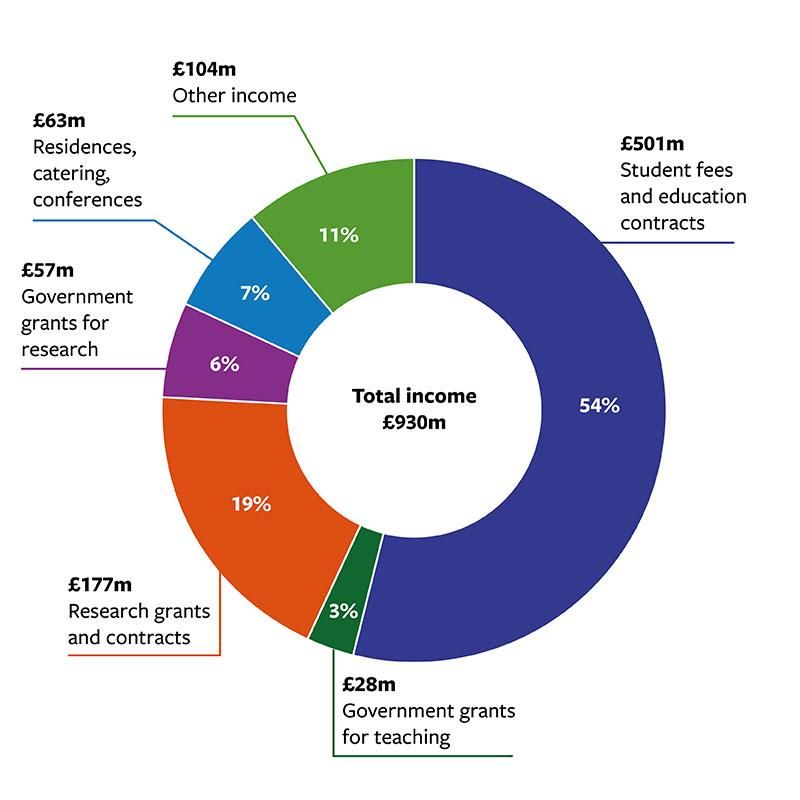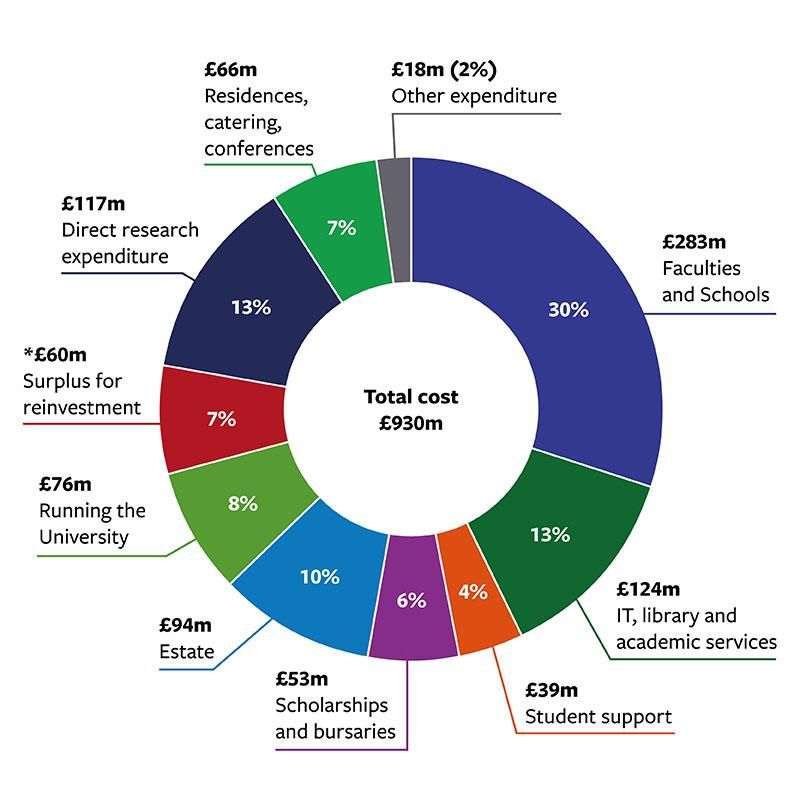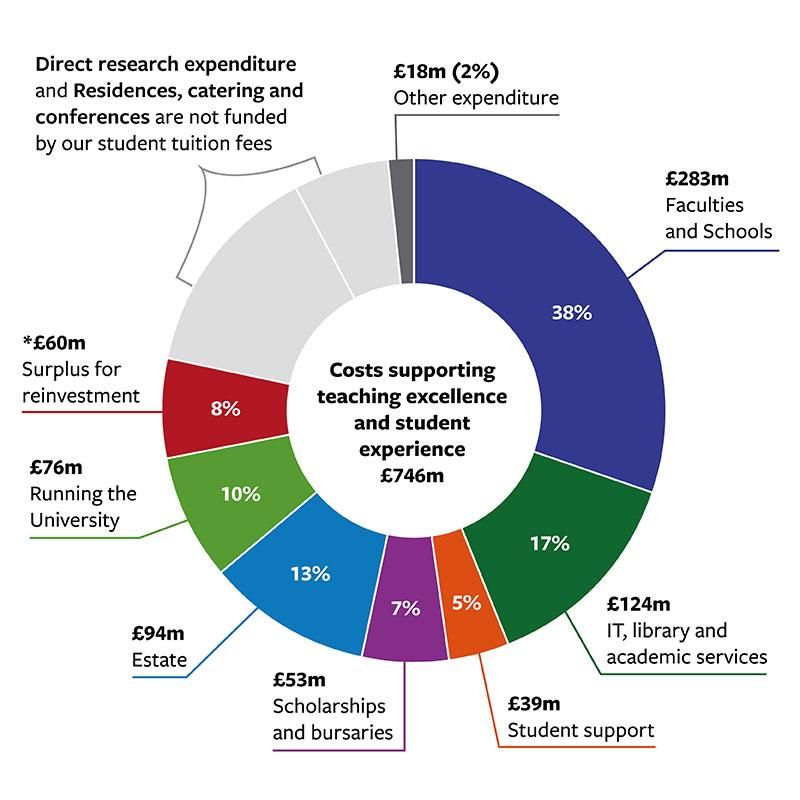Our income and how we spend it
The financial information on this page relates to the financial year that ended on 31 July 2022. We refer to this as “2021/22” in the text. Where we refer to “2020/21”, we mean the financial year ended 31 July 2021.
The following sections provide an explanation of our sources of income in 2021/22 and the expenditure and activity which they fund.
Note: all percentages have been rounded to the nearest percentage point for clarity.
Breakdown of income

The University has several income sources to support its work, including student fees and education contracts, government grants, other income through commercial activities including residences, catering and conferences, as well as donations. We also attract research grants from charities, research councils, companies and other organisations that help us fund our world-class research activity.
We use this income to support a wide range of activity including teaching and learning, cutting-edge research, knowledge exchange and community engagement. Research-based teaching and learning excellence, a high-quality student experience and successful student outcomes are at the centre of everything we do at the University.
In 2021/22 we received income of £501 million from student fees and education contracts, alongside £177 million from research grants and contracts. Student fee income in 2021/22 included £33 million of postgraduate taught fee income which would ordinarily have been recorded in 2020/21 but for which the teaching was partly deferred into 2021/22 as a result of the pandemic. Student fee and research income was supported by government grants of £85 million, with £28 million of this relating to teaching activity and £57 million to research.
The remainder of our income was made up of £63 million for residences, catering and conferences and £104 million from other income streams, such as income from hospitals and health authorities for direct support from the University, our National Institute of Health Research (NIHR) coordination centre, capital grants from funding bodies and donations.
Breakdown of expenditure

*Note: the £60 million surplus for reinvestment in 2021/22 includes £33 million of postgraduate taught fee income which would ordinarily have been recorded in 2020/21 but for which the teaching was partly deferred into 2021/22 as a result of the pandemic. Adjusting for that one off item, we would show £27 million surplus for reinvestment.
Expenditure in 2021/22 totalled £930 million (including the surplus for re-investment). Of this, £746 million supported teaching and the student experience here at Leeds and this is broken down further in the next section.
The remaining £184 million spend comprised £117 million of direct research expenditure and £66 million on residences, catering and conferences – none of which are funded by student tuition fees.
How do student fees contribute to the costs of running our University?

*Note: the £60 million surplus for reinvestment in 2021/22 includes £33 million of postgraduate taught fee income which would ordinarily have been recorded in 2020/21 but for which the teaching was partly deferred into 2021/22 as a result of the pandemic. Adjusting for that one off item, we would show £27 million surplus for reinvestment.
Student fees and education contracts totalling £501 million represent a significant portion of our University income, which contribute to the £746 million costs necessary to support teaching and research-based teaching.
Our students' fees pay for lecturers and other academic staff, building maintenance, as well as maintaining equipment and laboratories – at £283 million, this makes up a significant proportion of our expenditure, as we want to ensure our students get the best possible education. We provide this by investing in teaching facilities and attracting teaching staff who are actively engaged in pioneering research.
Student fees also contribute to our student support and academic services, which are important to the student experience. In 2021/22 we spent £39 million on student support, which includes services such as counselling, disability support, financial advice and mental health support. We also spent £124 million on our IT, library and academic services whose facilities aid learning outside of the lecture theatre and are accessible to all of our students. This figure also includes £24 million of expenditure on our National Institute of Health Research (NIHR) coordinating centre. Furthermore, we are proud to invest £53 million in scholarships and bursaries to ensure all our students have the opportunity to realise their potential, regardless of background.
We also need to spend money behind the scenes on essential things that keep our University running, like utilities, insurance, maintaining the estate and the wide range of staff who provide essential services, for example cleaning, human resources and finance. In 2021/22 we spent £188 million on these activities – £94 million on our estate, £76 million on general running costs and £18 million on other expenditure.
Investment in our University strategy
In 2020/21, we launched our 2020-2030 strategy which sets out our ambitions to build a thriving community and a collaborative culture to make an impact locally and globally in the areas of research and innovation, student education, digital transformation and international.
Delivering this strategy requires significant investment in our digital and technological capabilities as well as in the further development of our campus, buildings and facilities. It also requires investment to enable further innovation in the way we teach, carry out research and collaborate with other universities and organisations.
The charts on this page show a £60 million surplus for reinvestment. In the previous year we recorded a deficit because of the financial impacts of COVID-19. As explained on this page, it is important to note that the surplus in 2021/22 is inflated by the recording of £33 million of postgraduate taught fee income which would ordinarily have been recorded in 2020/21 but for which the teaching was partly deferred into 2021/22 as a result of the pandemic. Adjusting for that one off item we would show £27 million surplus for reinvestment.
The surplus that we have generated in 2021/22 is important to help support investment that is being made to deliver the University strategy and to continue to improve campus facilities, with student experience and outcomes being at the heart of that investment. 2021/22 saw the start of investment in the initiatives that will deliver our 2020-2030 strategy. These initiatives include:
- our exciting and innovative Curriculum Redefined programme;
- the continued delivery of the Student Life Cycle programme, which aims to improve systems and processes which affect the student experience from admission through to graduation;
- the Digital Transformation strategy, which includes a series of initiatives that will digitise many aspects of both research and student education, including investment in equipment, facilities and digital capability across the campus;
- our IT capability, ensuring that we have a robust infrastructure and a stable base to enable delivery of our Digital Transformation strategy;
- improving corporate processes and systems to ensure that the University’s support functions can operate as efficiently and effectively as possible.
In addition to these strategic initiatives, in 2021/22 the University invested £37 million predominantly in new academic facilities, equipment and infrastructure improvements. We plan to increase the investment in our campus over the coming years. An important part of this will be the delivery of our Climate Plan including our Net Zero strategy, as well as delivering digital facilities and physical infrastructure.